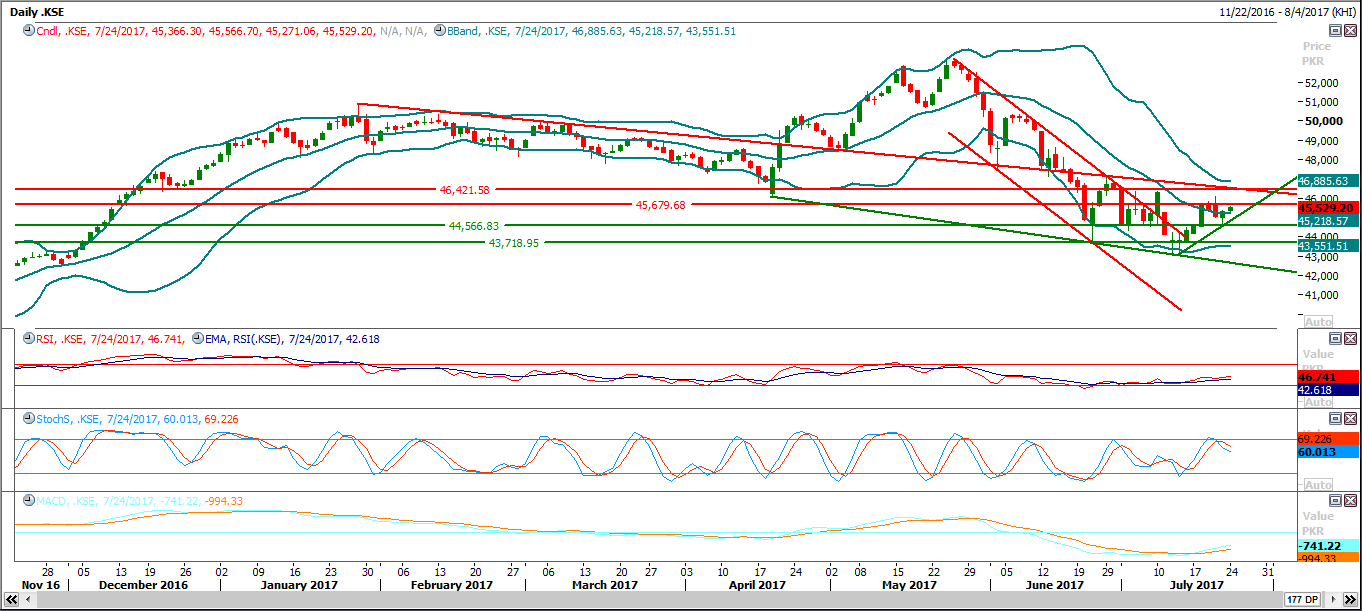Previous Session Recap
Trading volume at PSX floor dropped by 16.6 million shares or 13.55%, DoD basis, whereas the Benchmark KSE100 Index opened at 45366.30, posted a day high of 45566.70 and a day low of 45271.06 during the last trading session. The session suspended at 45529.20 with a net change of 234.81 points and a net trading volume of 50.08 million shares. Daily trading volume of KSE100 listed companies dropped by 3.53 million shares or 6.24%, DoD basis.
Foreign Investors remained in net selling positions of 2.6 million shares and the net value of Foreign Inflow dropped by 0.64 million US Dollars. Categorically, Foreign Corporate and Overseas Pakistani investors remained in net selling positions of 0.75 and 1.85 million shares. While on the other side, Local Individuals, Companies and Banks remained in net selling positions of 0.52, 1.2 and 0.43 million shares, respectively. However, Mutual Funds and Brokers remained in net buying positions of 4.04 and 0.5 million shares.
Analytical Review
The dollar crept up from a 13-month low on Tuesday after stronger-than-expected readings on U.S. factory and services activity ahead of the start of a Federal Reserve meeting later in the day, but Asian stocks were subdued. MSCI broadest index of Asia-Pacific shares outside Japan .MIAPJ0000PUS was flat in early trade, with a number of markets looking for fresh impetus after hitting multi-year highs in recent weeks. Japanese Nikkei .N225 rose 0.3 percent and Australian stocks jumped 0.35 percent, making up some 0.6 percent slide of Monday. South Korean KOSPI .KS11 was little changed.
Oil production of Pakistan grew three per cent to 88,189 barrels per day (bpd) in 2016-17, according to a research note issued by Topline Securities on Monday. Temporary shutdowns suffered by some major oil companies affected production at the start of 2017. As a result, oil production averaged 95,000bpd initially. Oil production went up 10pc year-on-year to about 91,000bpd during June. However, on a month-on-month basis, it was up 11pc, owing to the low-base effect. Nashpa field, which accounts for 26pc of Pakistan’s total oil production, experienced a brief shutdown in May. Although oil production growth of the country in 2016-17 was just 3pc, major listed exploration and production companies registered an increase of 9-11pc.
Manufacturers on Monday said that they will stop urea sales in case the government fails to issue fertiliser subsidy notification. Earlier this month, manufacturers resumed urea sales after getting assurances by the Ministry of Finance as well as the Ministry of Food Security and Research that a notification will be issued within 10 days. Fertiliser Manufacturers of Pakistan Advisory Council (FMPAC) in a statement said the government has not issued the notification so far. “This apathy shown by the government may once again force the industry to stop the sale of urea.
The International Monetary Fund’s (IMF) World Economic Outlook (WEO) on Monday projected that growth will slow down in Middle East, North Africa, Afghanistan (MENA) and Pakistan region and slip to 2.6 per cent in 2017 but will recover to 3.3pc in 2018. The forecast reflects primarily a slowdown in activity in oil exporters, before recovering in 2018. The latest IMF World Economic Outlook (WEO) forecast for 2017-18 is not very different from the one issued in April 2017, however the growth outcome in 2016 is estimated to have been considerably stronger in light of higher growth in Iran. “The recent decline in oil prices, if sustained, could weigh further on the outlook for the oil exporters of region,” the outlook notes.
Exports of non-textile products fell four per cent year-on-year to $7.99 billion in the outgoing fiscal year. The exports of these products fell despite the government support, according to the data compiled by the Ministry of Commerce. The share of these products also fell to 39pc in the outgoing fiscal year from 40pc in the previous year. It clearly reflects that reliance on exports of textile and clothing sectors increased over the past few years. In the non-textile sector, cement exports dropped 26pc in value and 24pc in quantity due to declining exports to South Africa following the imposition of anti-dumping duties.
The Market is expected to remain volatile today. We advise Traders to exercise caution. Buying on dips and booking gains on strength is recommended.
Technical Analysis
The Benchmark KSE100 Index is finding support from a rising trend line on daily and hourly chart and if it maintains its supports above that trend line, then it can target 45680 and 45760 during the current trading session. Breakout of 45780 will call for a spike towards 46360 and 46421 where its capped by a horizontal resistant and a resistant trend line, those resistances could push the index backwards for a breather. For the current trading session, buying above 45200 with strict stop loss of 44560 is recommended.
 To Open picture in original resolution right click image and then click open image in a new tab
To Open picture in original resolution right click image and then click open image in a new tab


0 Comments
No comments yet. Be the first to comment!
Please log in to leave a comment.